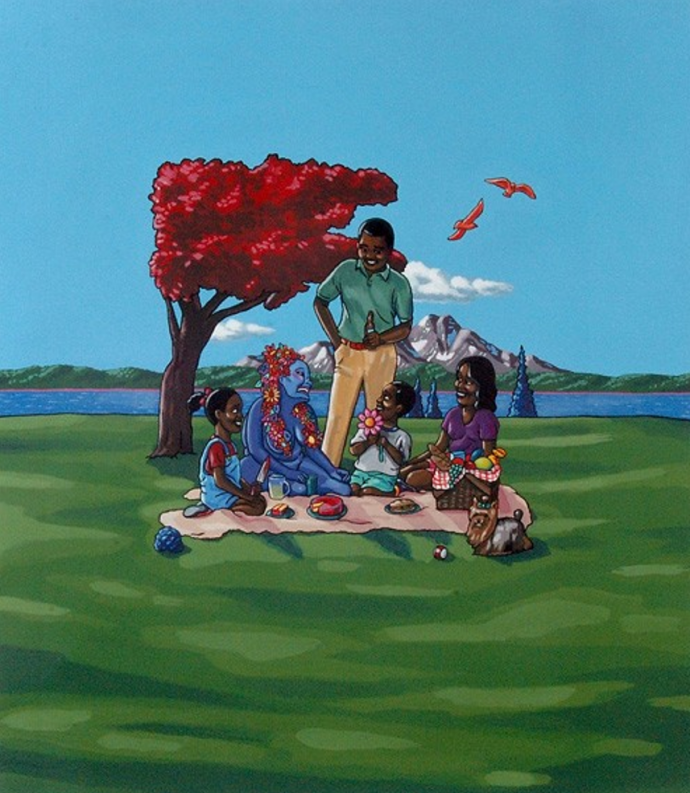Lamar Peterson Lances Racial Stereotypes

In Lamar Peterson’s series, Suburbia Sublime, he explores the African-American experience of race, community, upheaval and economic disparity. Through the use of vibrant colors and exaggerated characters, Peterson addresses African-American gullibility, masculinity, religion, family and human interaction. Inspired by simplistic illustrations that are routinely tacked on school bulletin boards or distributed in pamphlets at community events, Peterson creates irrational happy tableaus populated by hints of menacing social stereotypes from the real world. This is especially seen in two pieces, Mother Nature’s Favorite Flower and Untitled, which are on display at the Orlando Museum of Art from September 27, 2014 to January 4, 2015.

Mother Nature’s Favorite Flower, 2003.
Acrylic on paper. [courtesy of the artist and Fredericks & Freiser Gallery, New York.]
In this painting, the attention of all the figures is focused on the mysterious blue woman seated on the picnic blanket. Although the woman has a large smile it appears pained. The young girl is holding a knife stained with what could be blood or icing residue from cutting the cake on the blanket. Although the children are smiling, they appear to be nervous, as if the smiles are only a façade. This could be a family whose perfect benign exteriors mask deeper concerns. The young boy holds his flower protectively toward his face as he peers at the blue figure while leaning away from her. The adult male figure standing above the others could be an authoritative figure overseeing the others, most likely the father/ husband. Traditional picnic food items such as cake, bread and fruit are seen on the blanket and in a picnic hamper. Peterson even includes the family dog. A picture-perfect family is having an outing. However, Peterson includes an unknown figure, the blue woman who is reminiscent of a Hindu Goddess. The blue goddess, a figure the viewer can’t immediately identify, creates unease for the viewer.
The piece is arranged in a traditional triangular composition. This composition is created by the placement of the subjects. The standing male figure is the center point of the triangle, manifesting his authority and importance. The eye travels across the painting through the leading lines created by the gaze of the subjects. The figures on the left look toward the right and the figures on the right look to the left. This causes the eye to sweep over the whole pictorial frame, focusing on each figure individually. Interaction between the subjects is found only in the way they look at each other.
Peterson uses very vivid and highly saturated colors throughout this painting. There are numerous green hues used to create the grassy field in which all the figures are placed. When painting the family’s clothes, Peterson did not repeat a color, giving each subject an individual style. Even the blue of the Goddess-like woman is a different tone then the water that is seen behind them. The rich red used to create the lone tree behind the group causes it to stand out from the middle ground. In the foreground the people have black outlines that separate them from their surroundings, almost in a comic style. The soft scenery in the background is juxtaposed against the sharp edges of the foreground. The mountains have a slightly more realistic style in comparison to the surreal appearance of the people in the foreground.
In Lamar Peterson’s painting Untitled, a naked woman of color is seen lying serenely in the shade on grass. This painting presents a traditional subject of a reclining nude on grass, but also includes peculiar details that mock the idyllic scene. Behind the woman are flowers that have “minstrel-show black faces.” The woman is seen gazing at a white flower with very little features. The flowers behind her look jovial as they laugh and watch as one blows bubbles. These mischievous flowers seem to be enjoying the view of the woman. A blue flower has its leaves wrapped around the woman’s legs suggestively. The use of black faces on the flowers is like the theatrical makeup worn by white actors to represent black people in minstrel shows that were popular from the 1830s until 1910. Minstrel shows lampooned black people as dim-witted, lazy, buffoonish, superstitious, happy-go-lucky, and musical. [Wikipedia] Peterson is calling our attention to the continuation of racial stereotypes in the 21st century.

Untitled, 2004. Acrylic on paper.
[courtesy of the artist and Fredericks & Freiser Gallery,New York]
Warm green tones are found throughout the painting. There are a few sunlight patches on the woman and on the grass surrounding her. This implies that she has a canopy of leaves above her, and the sun is shining through small openings in the branches. The bushes that frame the woman from left to right lighten at the top of the painting suggesting more sunlight penetrating through the greenery. The background has very soft tones that create a vanishing point. The flowers behind the figure are very bright in color drawing the viewer’s eye. The white flower that the woman is distracted by, which is also in a patch of sunlight, is very plain in comparison to the more vivacious flowers with black face.
Through these paintings Lamar Peterson successfully causes the viewer to question and consider racial stereotypes. He positions colorful subject matter within serene scenery to create a contrasting narrative. He mixes fantasy and reality to explore a very complex subject matter, which is often masked by simplistic imagery in the real world.

